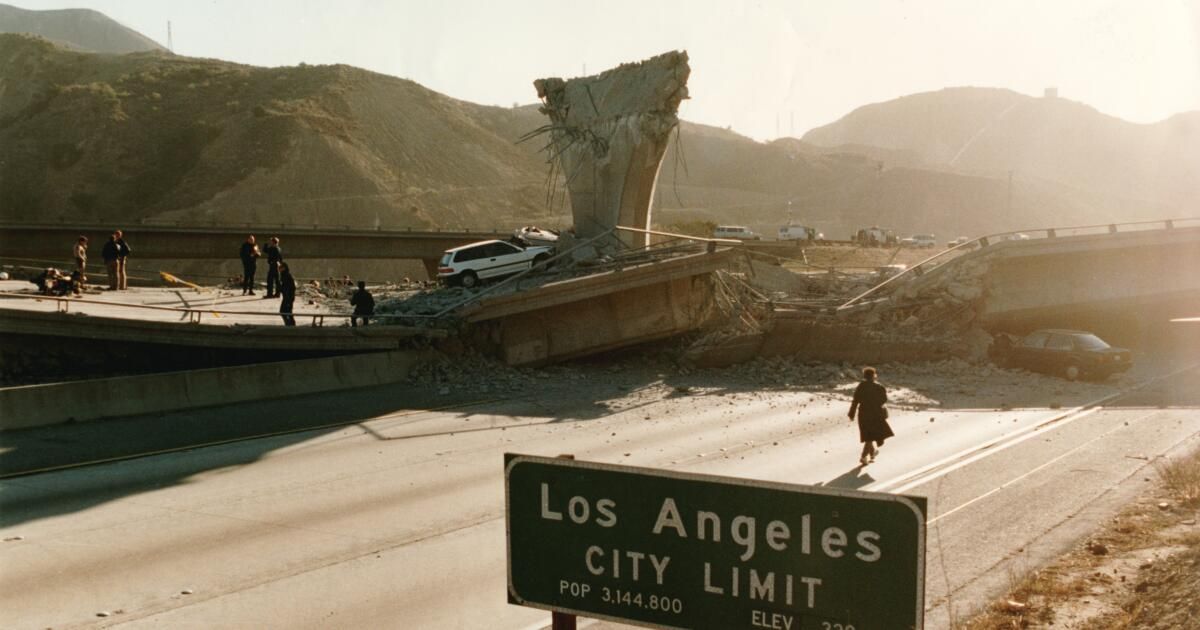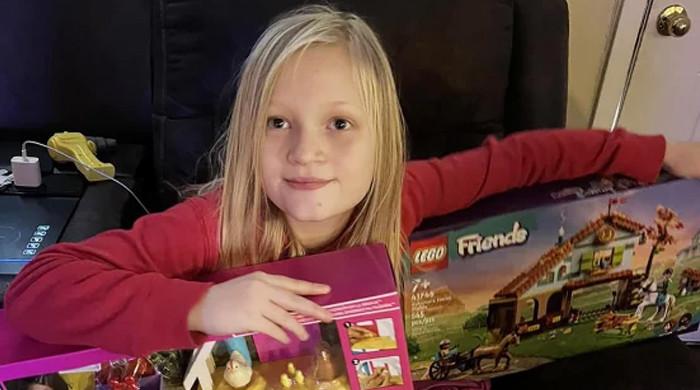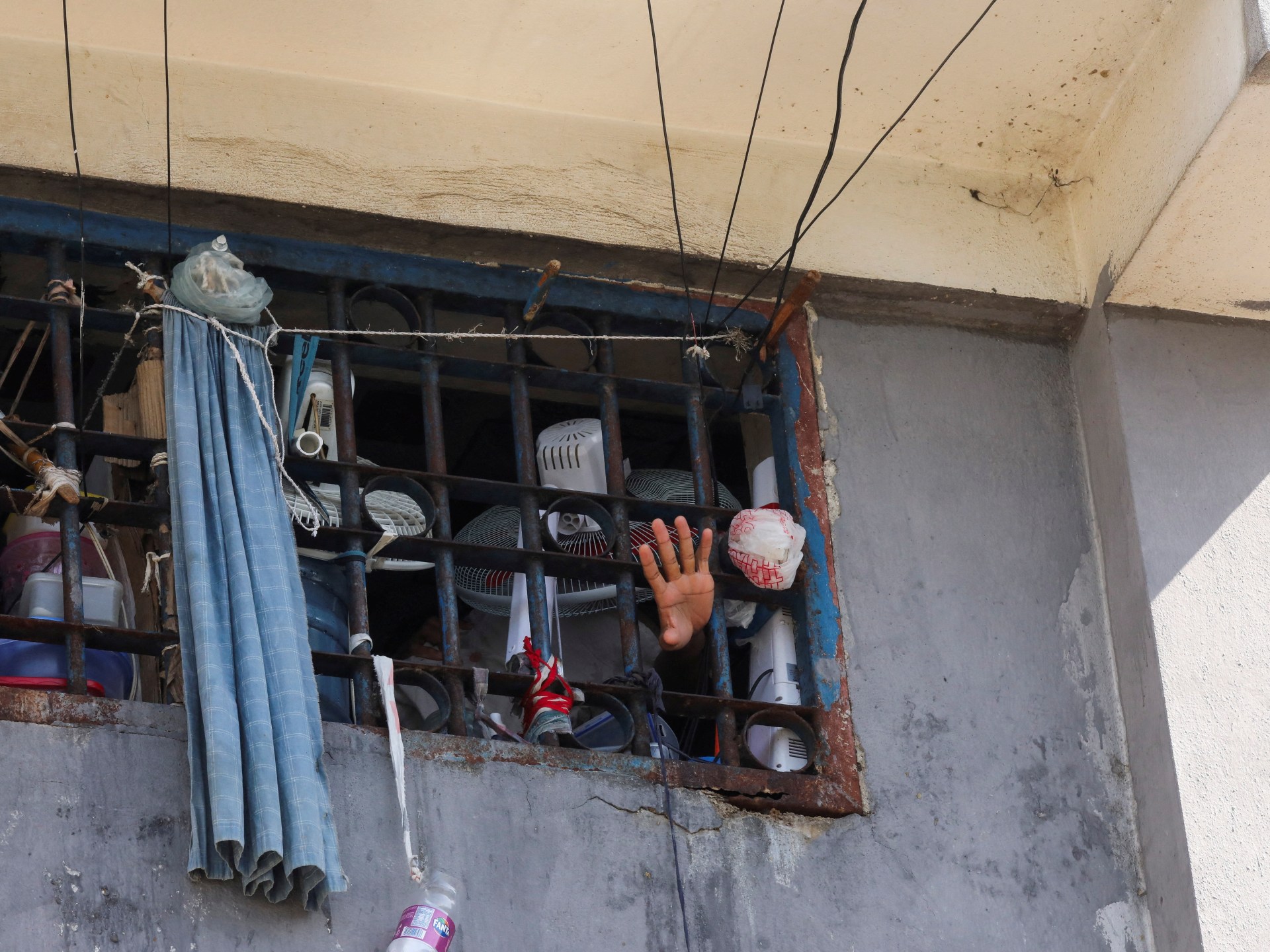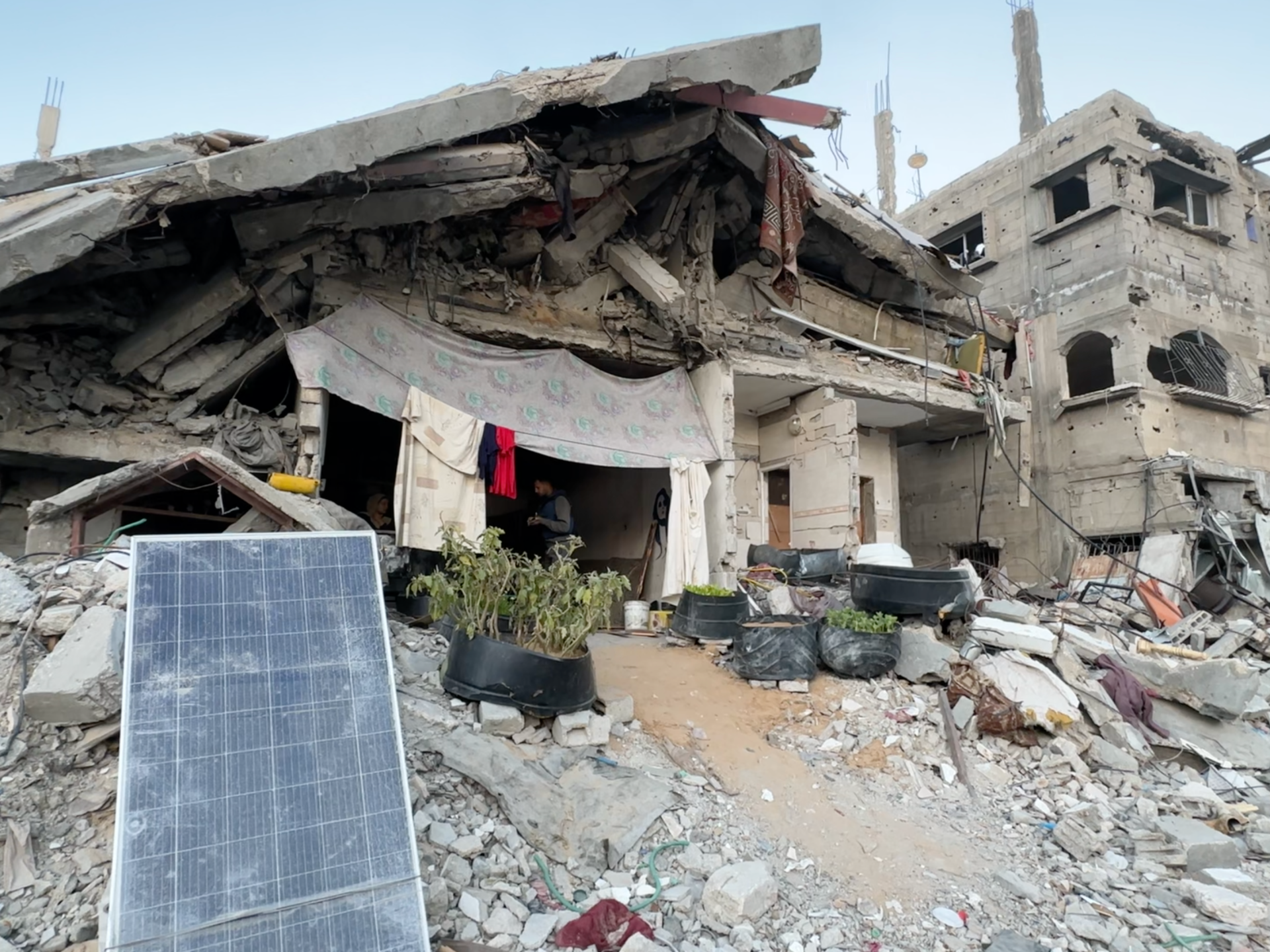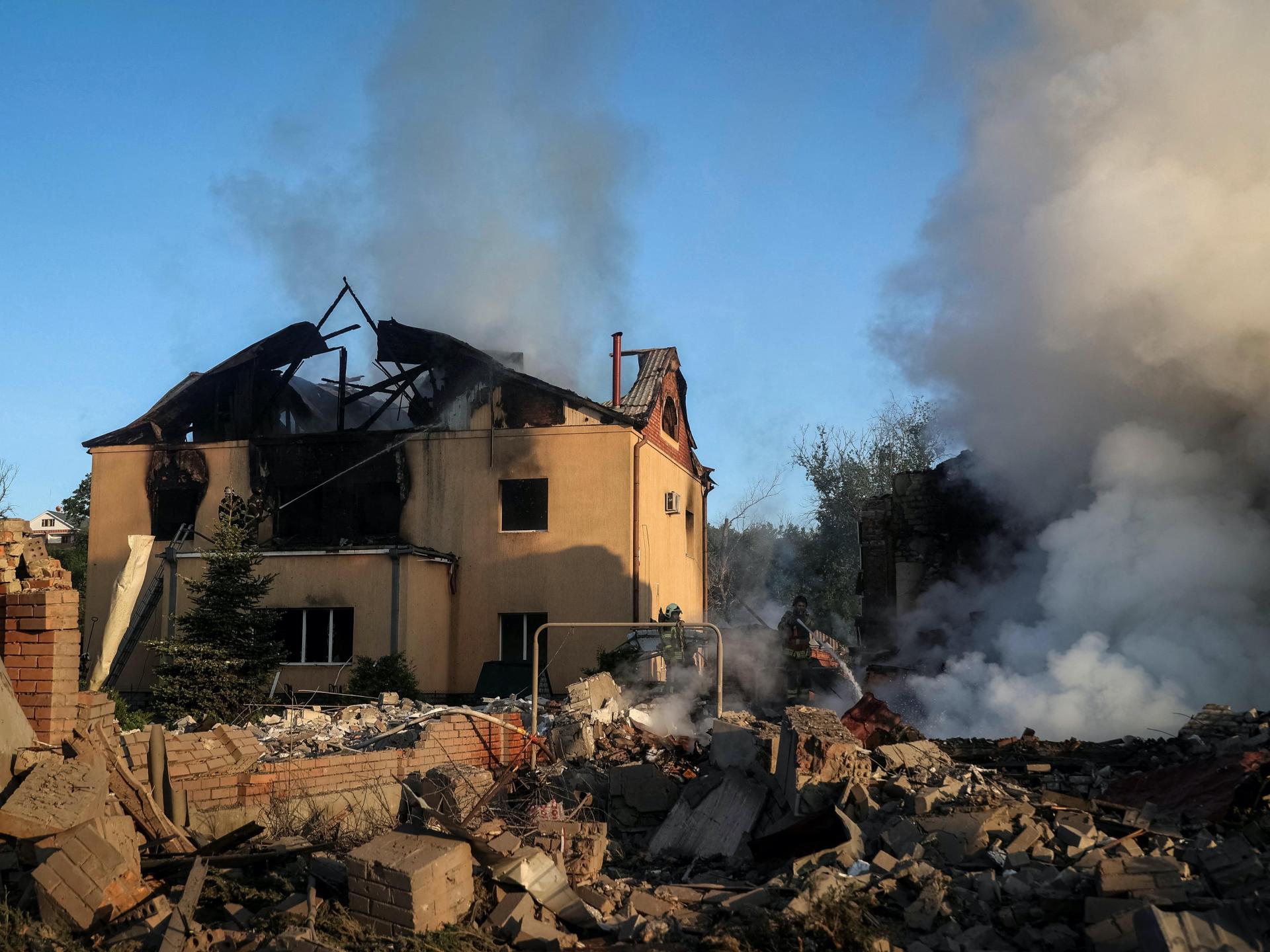The walls bend. Refrigerators walk. Televisions fly. I learned all this and more 30 years ago today, when I was startled awake at 4:31 a.m. by the magnitude 6.7 Northridge earthquake.
It was not the first time I heard that terrifying, guttural roar of tectonic plates colliding or felt the ground shake and roll under my feet. I was born and raised in Los Angeles, so unlike my friends and neighbors who emigrated from other places, there was no way to confuse that primal feeling with the sound of an approaching train or a passing truck. Earthquakes are nature, in all its power, reminding us that we are completely insignificant.
But even in Los Angeles terms, the 1994 earthquake was no ordinary tremor.
The sound of an entire city abruptly rearranging itself on a thrust fault was deafening, so much so that it obscured the crash of my bathroom mirror shattering, windows shattering, and the kitchen cabinet violently spitting its contents onto the hard tile floor.
A man looks down the street from what remains of his apartment in Northridge Meadows.
(Los Angeles Times)
But my bare feet certainly felt the shards of ceramic coffee cups and the slippery surface of scattered CD cases as I ran for cover. Back then, we were told to take shelter under a door frame, so I chose the front door.
Outside my apartment in Los Feliz, the utility poles swayed like they were drunk. Sparks flew as cable lines arced and burst, generating the last DWP-generated light it would see before the power went out, leaving the city pitch black aside from the fires and flashing sirens. It was déjà vu all over again, never mind that the previous terrifying Los Angeles disaster had been man-made.
The riots that followed the Rodney King verdict were barely 18 months old and the fear of a city on the brink of total destruction still hung in the air. It also didn't seem like a coincidence that the earthquake occurred on the day we were supposed to celebrate Martin Luther King Jr.'s birthday.
Although many of the buildings and streets that were damaged in the riots had been restored, or at least cleaned, the conditions that sparked the uprising were still at play: systemic racism, police brutality, obscene displays of wealth within blocks of generational poverty. It was as if a higher power was reminding us that it would take much more than construction equipment to fix what was broken.
Adding to a sense of instability and danger that permeated the city even before the shaking began, the South had been rocked by unprecedented violent crimes. Los Angeles County experienced a staggering 2,589 murders in 1992. For context, that's almost four times more than the 651 in 2023. The era felt like something akin to the end of times, minus the horsemen and the locusts.
But earthquakes were a part of life for native Angelenos and of all life. My mother's side of the family goes back three generations here, and they all had their traumatizing earthquake stories. My grandmother often talked about the 1933 Long Beach earthquake (magnitude 6.4). My biggest was the Sylmar earthquake in 1971 (6.6).
(It's sobering to note that California has yet to experience the real Big One. The earthquake that hit Fukushima, Japan, in 2011 had a magnitude of 9.0.)
As for me, earthquake preparedness drills were simply part of my education in the Los Angeles Unified School District. Learning to duck and cover was as regionally specific to Southern California schools as were “smog alert holidays,” joyful occasions when ozone levels reached such dangerously high levels that classes were canceled.
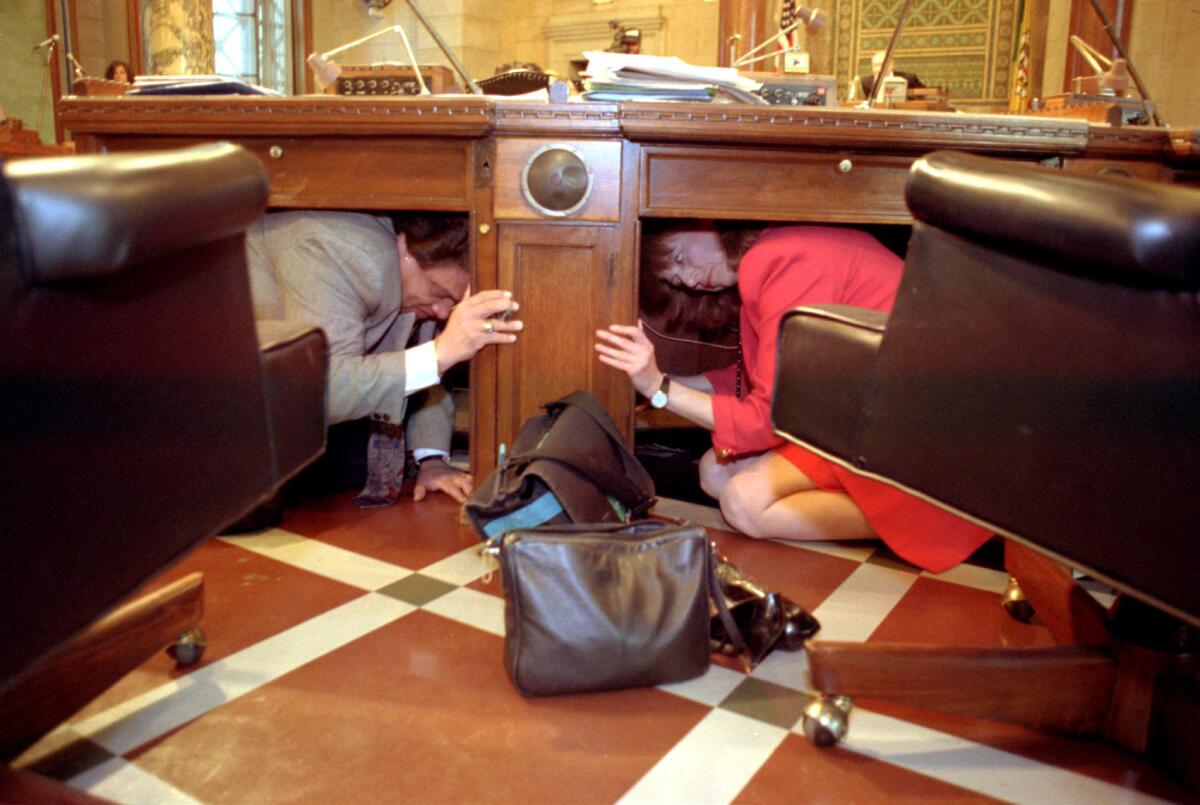
Members of the Los Angeles City Council take shelter under desks during a drill to prepare for the 1993 earthquake.
(Axel Koester / for The Times)
I was in my mid-20s when the Northridge Fault hit, so I should have known I had a pair of shoes at the foot of my lumpy futon and a flashlight with fresh batteries on the nightstand (aka a milk carton). plastic). But not. When the shaking hit, I did almost everything wrong, including groping around barefoot in the dark.
What I could see were the distorted walls as the 1940s four-unit building swayed back and forth. I can still hear the popping and creaking of plaster and wood.
Later, when the sun came up, I discovered that my refrigerator had wobbled from the wall to the center of the small kitchen, and that my flat-screen TV, which was pre-flat, had flown halfway across the room from its shelf earlier. from being dragged back. by its electrical cable and thrown against a wall.
There was no possibility of watching the news on television anyway. The power went out. Contacting loved ones was also impossible: landlines were dead and '90s cell phones rarely picked up a viable signal on a good day. So we sat in our cars listening to the news.
Miraculously, the Times arrived the next morning and the sound of the newspaper being thrown into driveways provided a semblance of normality amid the chaos. But what we learned from the printed stories was anything but comforting.
Parts of the 5, 10 and 14 freeways had collapsed. Streets flooded and burned simultaneously due to burst water and gas pipes. A newly constructed parking lot on the Cal State Northridge campus had collapsed and support columns were twisted like candy.
The aftershocks (6.0, 5.7, 5.5) made everyone nervous. For weeks, dozens of frightened Angelenos slept outside on patios and sidewalks, fearing their apartment buildings would collapse. Surely this is unimaginable to younger Angelenos: of the 10 million residents of Los Angeles County, according to the census, 3.8 million were not born when Northridge arrived.
Traumatized office workers bypassed the elevators and huffed up the stairs. And like many motorists, I would no longer stop under a bridge or overpass, no matter if it meant there was a large, empty space in front of me while I waited for the light to change.
We became familiar with terms like “red-tagging” (meaning the city had marked a building as unsafe to enter) and came to know the names of the places where the earthquake hit hardest. The Northridge Meadows apartments became a central focus of the city's mourning after 14 of the 57 people who died in the quake were found crushed under the rubble.
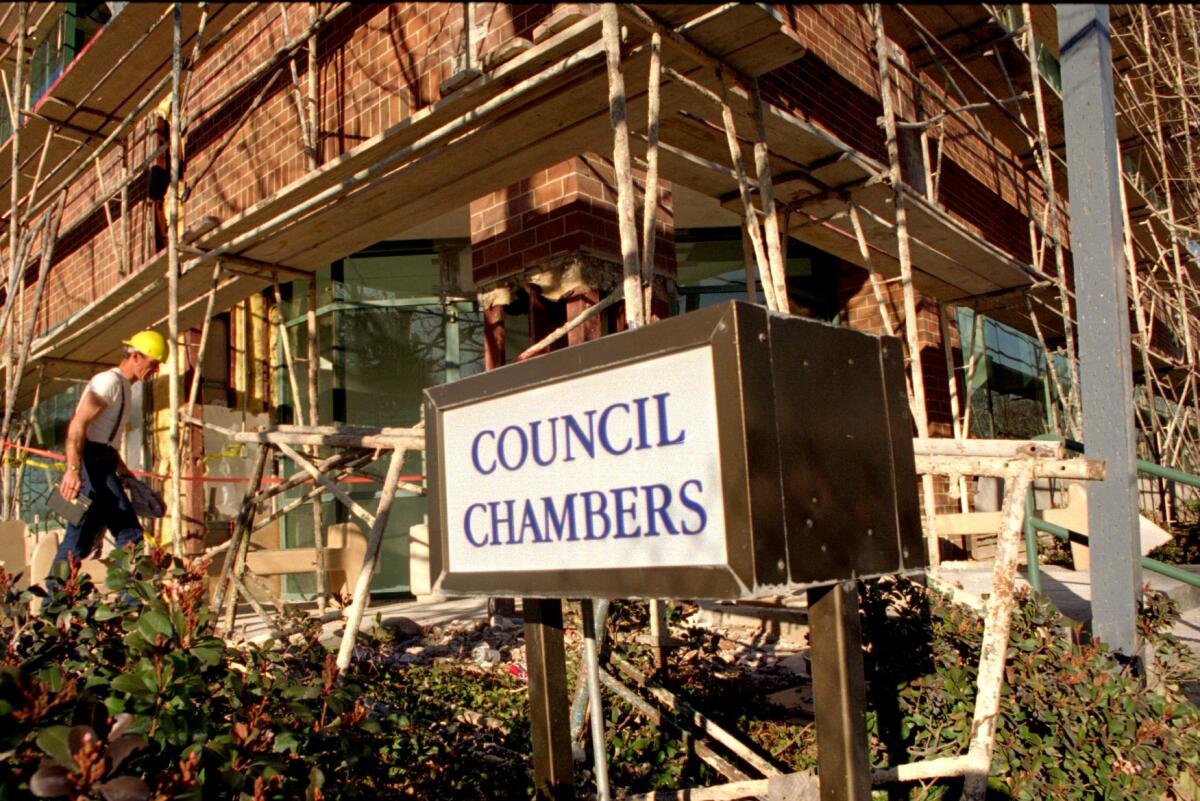
Santa Clarita City Hall suffered extensive damage.
(Jonathan Alcorn / For The Times)
He would later see firsthand the extent of the destruction while driving through Hollywood, where the sides of older, multi-story brick buildings had collapsed, exposing their contents like rooms in a dollhouse: kitchens with dishes still on them. on the table, a jacket thrown over the back of a sofa. Elsewhere, old houses that had been knocked off their foundations sank lazily to one side.
The city seemed destroyed and Time magazine declared that Los Angeles was going to hell. But we didn't do it. So maybe it's five times more expensive to live here now and the traffic is off the charts, but we're still here, despite the tremors and riots and gang warfare. And I have learned to always have a pair of shoes next to the bed.

